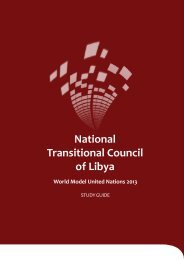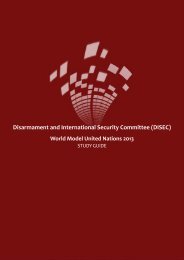Social, Humanitarian and Cultural Committee (SOCHUM)
Social, Humanitarian and Cultural Committee (SOCHUM)
Social, Humanitarian and Cultural Committee (SOCHUM)
You also want an ePaper? Increase the reach of your titles
YUMPU automatically turns print PDFs into web optimized ePapers that Google loves.
indigenous populations than in those without, not<br />
only for the indigenous peoples but also for nonindigenous<br />
groups living in the area. 170<br />
the dire situations that indigenous peoples face<br />
in Latin America is also evident in developmental<br />
indicators other than simple poverty rates. According<br />
to a study by the International Labour Organization,<br />
members of indigenous communities in Latin American<br />
earn approximately half of the income earned by the<br />
average non-minority citizen. 171 Such a statistic has<br />
obvious implications for indigenous peoples’ access<br />
to basic resources <strong>and</strong> services, including food,<br />
shelter, <strong>and</strong> healthcare, <strong>and</strong> underscores why the<br />
poverty rates among indigenous populations are so<br />
high. Indigenous peoples are also behind in indicators<br />
of overall health. Malnutrition rates, for example, are<br />
twice as high among the indigenous population than<br />
the majority ethnic groups. 172 unfortunately, as the<br />
overall population in most Latin American countries<br />
has seen progress toward economic development in<br />
recent years, this does not seem to be the case for<br />
indigenous groups. In Guatemala, the overall poverty<br />
rate has fallen almost thirty percentage points in the<br />
past twenty years, while the indigenous poverty rate<br />
has remained essentially the same. Some countries,<br />
like Chile, have seen poverty rates for indigenous<br />
peoples fall at the same pace as those for the general<br />
population, but they are the exception rather than<br />
the rule in Latin America. 173<br />
In Asia, another continent with significant<br />
indigenous populations, poverty rates for those<br />
indigenous peoples have been rapidly falling. In China,<br />
for example, the overall poverty rate has declined<br />
from 84% in 1981 to just 16% in 2005, <strong>and</strong> the rates<br />
among indigenous populations have actually fallen<br />
even more drastically than those for the majority<br />
Han ethnic group, though the overall percentage of<br />
indigenous poor remains higher than that of poor<br />
Han Chinese. Current estimates put the poverty rate<br />
among the indigenous population in China at 5.4%,<br />
by far the lowest among countries with a significant<br />
number of indigenous groups. 174 Vietnam <strong>and</strong> India<br />
have seen similar, though less extreme, progress,<br />
with poverty rates among indigenous peoples falling<br />
about 20% to current levels of 52.3% in Vietnam <strong>and</strong><br />
43.8% in India. An analysis of the statistics for Vietnam<br />
shows, however, that some changes in policy are<br />
necessary; while the poverty rate among indigenous<br />
peoples has fallen by about 20%, the poverty rate for<br />
the majority ethnic population fell over 40% in the<br />
same period. 175 While it is unclear whether declines<br />
in poverty rates mean that indigenous populations<br />
are actually doing better overall or, as this figure<br />
suggest, that there are other areas in which they still<br />
lag behind the majority ethnic group, these statistics<br />
In many of the world’s largest developing nations, the indigenous<br />
poverty rate is higher than that of the general population.<br />
41<br />
Melbourne Host Directorate PTY LTD | Office of Media <strong>and</strong> Design

















